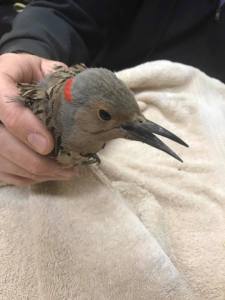This lovely bird is a Northern Flicker. It was found injured in the road by our friend Helen Powers, who was taking a walk along state land in Cobleskill at the time.
Thank you, Helen, for bringing the bird to NYWRC for help, and for giving us permission to use your photos in this post.
(Click any image for slide show, then use the “x” at the top right to return to this page.)
Northern Flicker Interesting Facts
The Flicker is a large member of the woodpecker family, though they are more often seen foraging for insects on the ground than in or on trees like their cousins. Their primary food is beetles and ants, as well as other ground-dwelling insects, but they supplement their diet with some fruit and seeds. These handsome birds, in addition to the red crescent on the neck and white flash on the rump when they fly, also have lovely color under the wings. In eastern birds, the wing undersides are yellow, and red in the west (thus the terms “yellow-shafted” and “red-shafted” often used to describe them).
While it’s not common for Flickers to eat at feeders, you can often find them sharing a bird bath with other species.
They will sometimes accept nest boxes to raise their young if the nest is of a good size, and in a protected spot. They prefer locations near the edge of forest and field. Both parents excavate a nest in dead or diseased tree trunks and large limbs. They raise one brood of 5 – 8 chicks per season, and the young leave the nest at around 27 days.
Unlike most woodpecker species, Flickers are strongly migratory. This is why, in our area of upstate New York, we watch for Flickers to return in the spring, and enjoy groups of them in the fall before they get ready to head south.




